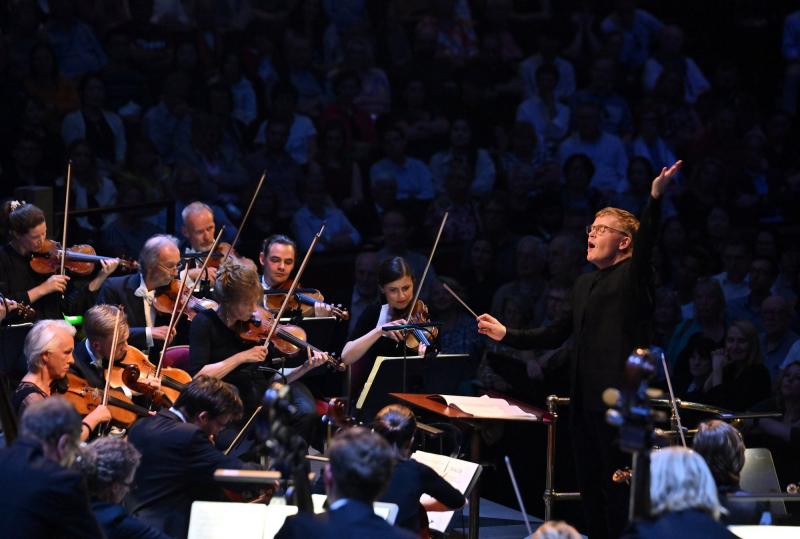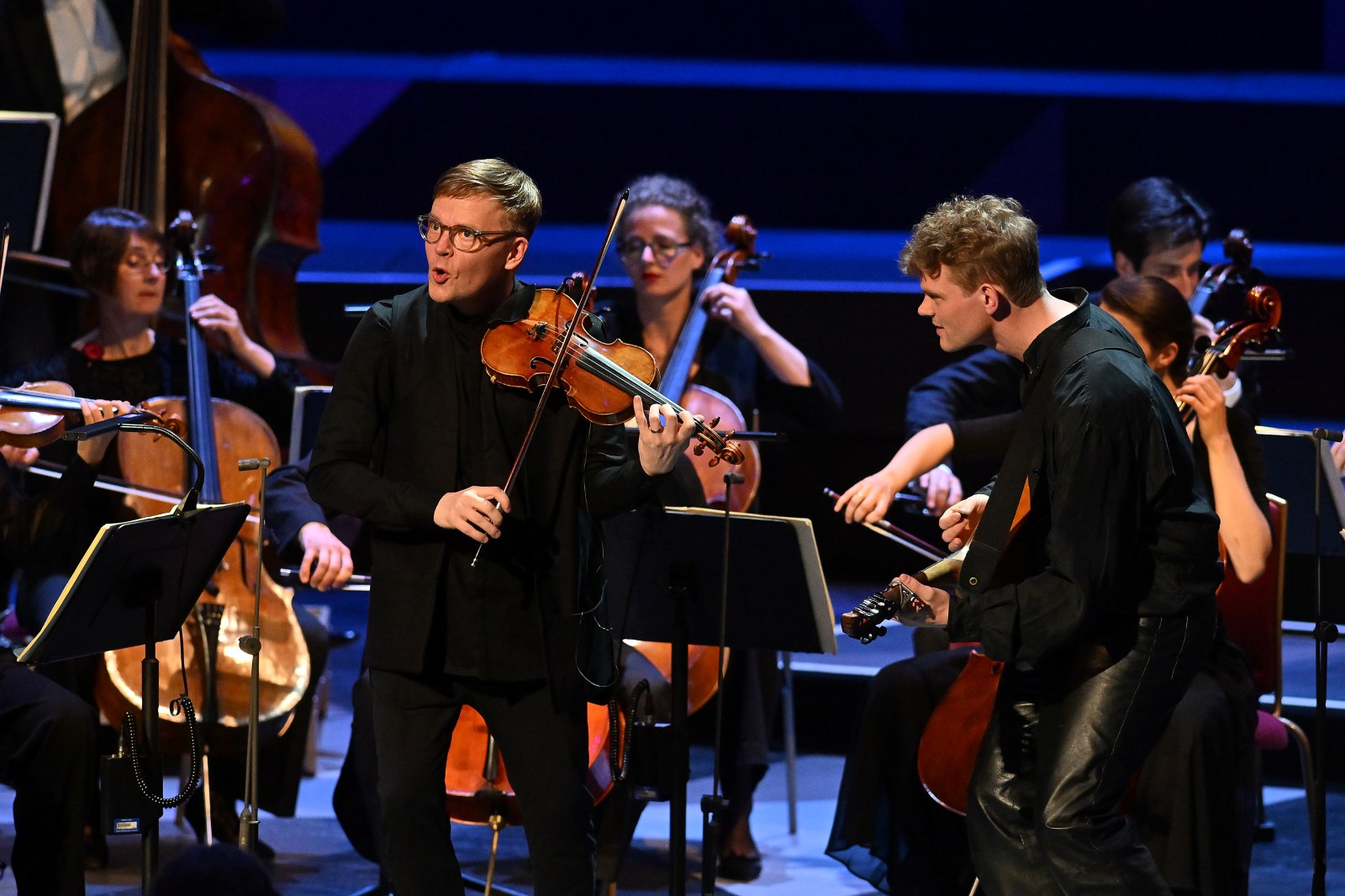Prom 4: Deutsche Kammerphilharmonie Bremen, Kuusisto review - Pekka Kuusisto's charisma shrinks the Royal Albert Hall | reviews, news & interviews
Prom 4: Deutsche Kammerphilharmonie Bremen, Kuusisto review - Pekka Kuusisto's charisma shrinks the Royal Albert Hall
Prom 4: Deutsche Kammerphilharmonie Bremen, Kuusisto review - Pekka Kuusisto's charisma shrinks the Royal Albert Hall
Vivaldi 'refreshed', as the celebrated violinist inspires as conductor with belief and vision

Pekka Kuusisto, making his Proms debut as conductor in the first half of this concert, and then as violinist/conductor/ringmaster/energiser in the second, brought lightness, playfulness, and a Finnish sense for the absurd to the Albert Hall. He is an absolutely live-wire performer and has a hugely charismatic musical presence. He radiates joy in his craft and also unfailingly communicates his appreciation for those around him.
Lightness and a sense of the dance were certainly there in Beethoven’s Symphony No. 1. Recent recordings of the Carl Friedrich Ebers chamber ensemble version of this work have served as a reminder of how joyous and fleet-footed it can sound; this performance managed to do exactly the same, but with larger forces. The scurrying first violin part of the trio of the third movement scherzo was absolutely breathtaking. The first violin section, led by the remarkable German violinist Daniel Sepec is such a strong unit, and their unanimity at fast tempi really is something special.
The Beethoven performance had one fascinating and surprising break with tradition. The six-bar adagio opening to the fourth movement was transformed into a call and response with the orchestra singing it, and then the Royal Albert Hall audience singing it back – complete with dynamics. Did it work? It certainly served to involve the audience and enable Kuusisto to "shrink the room", which in the cavernous Albert Hall is no mean feat.
Increasing playfulness was the hallmark of the opening work of the concert. Swedish composer Andrea Tarrodi’s Birds of Paradise II starts with an evocation of calm and serenity, and increasingly starts toying the idea of more or less all of the instruments of the orchestra imitating the sounds of nature – and of birdsong in particular – as closely as possible. It’s not all deadpan... when a bassoon joins in it probably never is. From the oboes, we heard the sound of breath, and from Jonas Krause, the same percussionist who would later give us precise, crisp and tight timpani work in the Beethoven, here we heard a wonderfully sustained and atmospheric shimmer on the cymbal. The TV recording of the concert inserts nature footage in the piece, so the birds of paradise are actually seen rather than just imagined from the instrumental sounds.  The second half of the concert was Vivaldi’s The Four Seasons, variously described in the programme as having been “refreshed” or as “interspersed with folk music improvisations”. There were some particularly stunning moments when Kuusisto was working in close cahoots with Daniel Sepec, who was leading the first violins, and Latvian violinist Marta Spārniņa, leading the seconds. Fabulous.
The second half of the concert was Vivaldi’s The Four Seasons, variously described in the programme as having been “refreshed” or as “interspersed with folk music improvisations”. There were some particularly stunning moments when Kuusisto was working in close cahoots with Daniel Sepec, who was leading the first violins, and Latvian violinist Marta Spārniņa, leading the seconds. Fabulous.
Kuusisto takes the approach of leaving the Vivaldi more or less untouched, but gives Swedish folk cittern player Ale Carr from the Skåne region of southern Sweden (photo with Kuusisto above by Mark Allan BBC) free rein to improvise over it, and then joins Carr in the improvisations, which take on a broad range of other themes which fit the context. Carr uses a capo to set himself in the right key and plays diatonically virtually throughout. The finest moment of Kuusisto and Carr together came in an interspersed section quoting part of Vaughan Williams’s The Lark Ascending. They were playing it fairly straight, and then making a dance theme out of it. I can imagine that idea will not have been to everyone's taste. I was interested rather than bowled over by Carr’s contribution, even though he and Kuusisto have clearly put in a lot of prior preparation. That said, I couldn’t help dreaming of what, say, Chris Thile, or even possibly Hamilton de Holanda might one day make of the opportunity to spar with this remarkable violinist in this music.
I don't think such doubts were widely shared: the applause at the end of the Four Seasons was unanimous, warm and loud. Kuusisto's sheer class and energy absolutely bring the audience in. And Deutsche Kammerphilharmonie Bremen, with all their community work in Bremen-Ost, always seem not just like a very fine orchestra, but also like a community/extended family with laudable shared ideals and beliefs. And they clearly value their relationship with their “Artistic Best Friend” Pekka Kuusisto, The star violinist and also – increasingly – an inspiring conductor with the belief and the vision to make this orchestra sound consistently superb.
rating
Explore topics
Share this article
The future of Arts Journalism
You can stop theartsdesk.com closing!
We urgently need financing to survive. Our fundraising drive has thus far raised £49,000 but we need to reach £100,000 or we will be forced to close. Please contribute here: https://gofund.me/c3f6033d
And if you can forward this information to anyone who might assist, we’d be grateful.

Subscribe to theartsdesk.com
Thank you for continuing to read our work on theartsdesk.com. For unlimited access to every article in its entirety, including our archive of more than 15,000 pieces, we're asking for £5 per month or £40 per year. We feel it's a very good deal, and hope you do too.
To take a subscription now simply click here.
And if you're looking for that extra gift for a friend or family member, why not treat them to a theartsdesk.com gift subscription?
more Classical music
 Echo Vocal Ensemble, Latto, Union Chapel review - eclectic choral programme garlanded with dance
Beautiful singing at the heart of an imaginative and stylistically varied concert
Echo Vocal Ensemble, Latto, Union Chapel review - eclectic choral programme garlanded with dance
Beautiful singing at the heart of an imaginative and stylistically varied concert
 Scott, Irish Baroque Orchestra, Whelan, RIAM, Dublin review - towards a Mozart masterpiece
Characteristic joy and enlightenment from this team, but a valveless horn brings problems
Scott, Irish Baroque Orchestra, Whelan, RIAM, Dublin review - towards a Mozart masterpiece
Characteristic joy and enlightenment from this team, but a valveless horn brings problems
 Classical CDs: Voice flutes, flugelhorns and froth
Baroque sonatas, English orchestral music and an emotionally-charged vocal recital
Classical CDs: Voice flutes, flugelhorns and froth
Baroque sonatas, English orchestral music and an emotionally-charged vocal recital
 Kanneh-Mason, Britten Sinfonia, Shave, Milton Court - a grin and a big beaming smile
A pair of striking contemporary pieces alongside two old favourites
Kanneh-Mason, Britten Sinfonia, Shave, Milton Court - a grin and a big beaming smile
A pair of striking contemporary pieces alongside two old favourites
 theartsdesk at the New Ross Piano Festival - Finghin Collins’ musical rainbow
From revelatory Bach played with astounding maturity by a 22 year old to four-hand jazz
theartsdesk at the New Ross Piano Festival - Finghin Collins’ musical rainbow
From revelatory Bach played with astounding maturity by a 22 year old to four-hand jazz
 First Person: Manchester Camerata's Head of Artistic Planning Clara Marshall Cawley on questioning the status quo
Five days of free events with all sorts of audiences around Manchester starts tomorrow
First Person: Manchester Camerata's Head of Artistic Planning Clara Marshall Cawley on questioning the status quo
Five days of free events with all sorts of audiences around Manchester starts tomorrow
 Goldscheider, Brother Tree Sound, Kings Place review - music of hope from a young composer
Unusual combination of horn, strings and electronics makes for some intriguing listening
Goldscheider, Brother Tree Sound, Kings Place review - music of hope from a young composer
Unusual combination of horn, strings and electronics makes for some intriguing listening
 theartsdesk Q&A: composer Donghoon Shin on his new concerto for pianist Seong-Jin Cho
Classical music makes its debut at London's K-Music Festival
theartsdesk Q&A: composer Donghoon Shin on his new concerto for pianist Seong-Jin Cho
Classical music makes its debut at London's K-Music Festival
 Helleur-Simcock, Hallé, Wong, Bridgewater Hall, Manchester review - moving lyricism in Elgar’s concerto
Season opener brings lyrical beauty, crisp confidence and a proper Romantic wallow
Helleur-Simcock, Hallé, Wong, Bridgewater Hall, Manchester review - moving lyricism in Elgar’s concerto
Season opener brings lyrical beauty, crisp confidence and a proper Romantic wallow
 Kohout, Spence, Braun, Manchester Camerata, Huth, RNCM, Manchester review - joy, insight, imagination and unanimity
Celebration of the past with stars of the future at the Royal Northern College
Kohout, Spence, Braun, Manchester Camerata, Huth, RNCM, Manchester review - joy, insight, imagination and unanimity
Celebration of the past with stars of the future at the Royal Northern College

Add comment